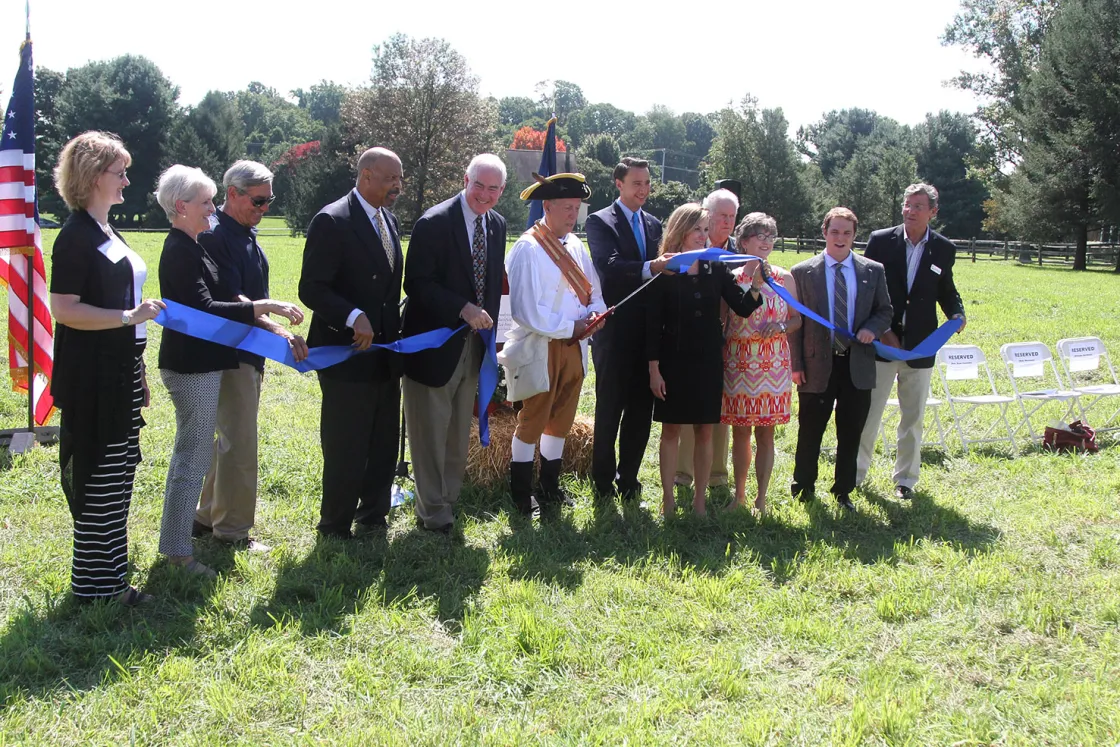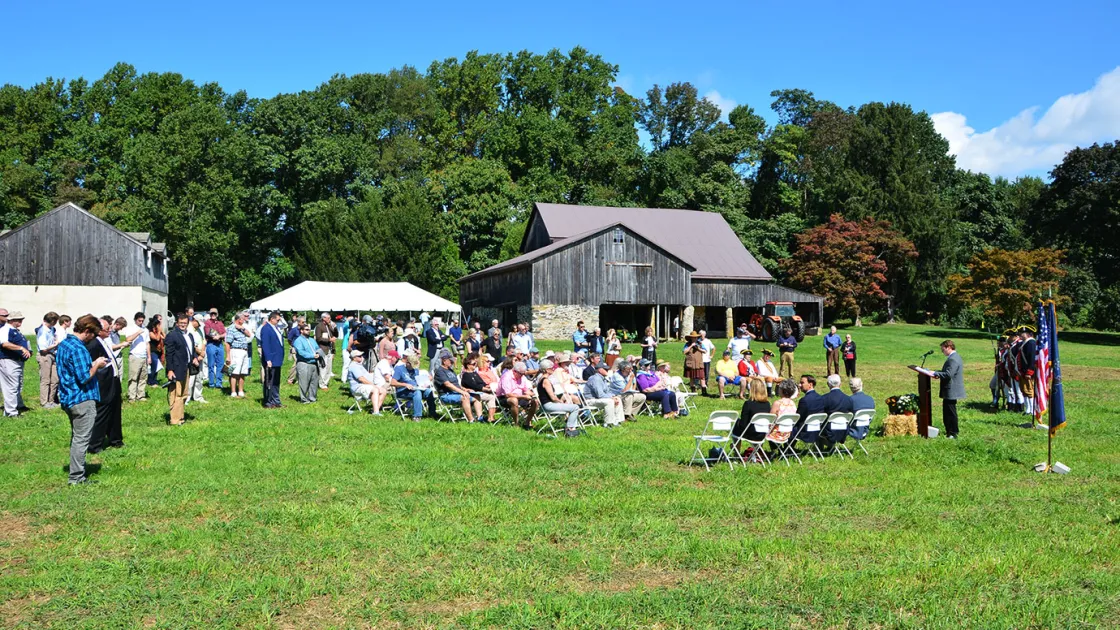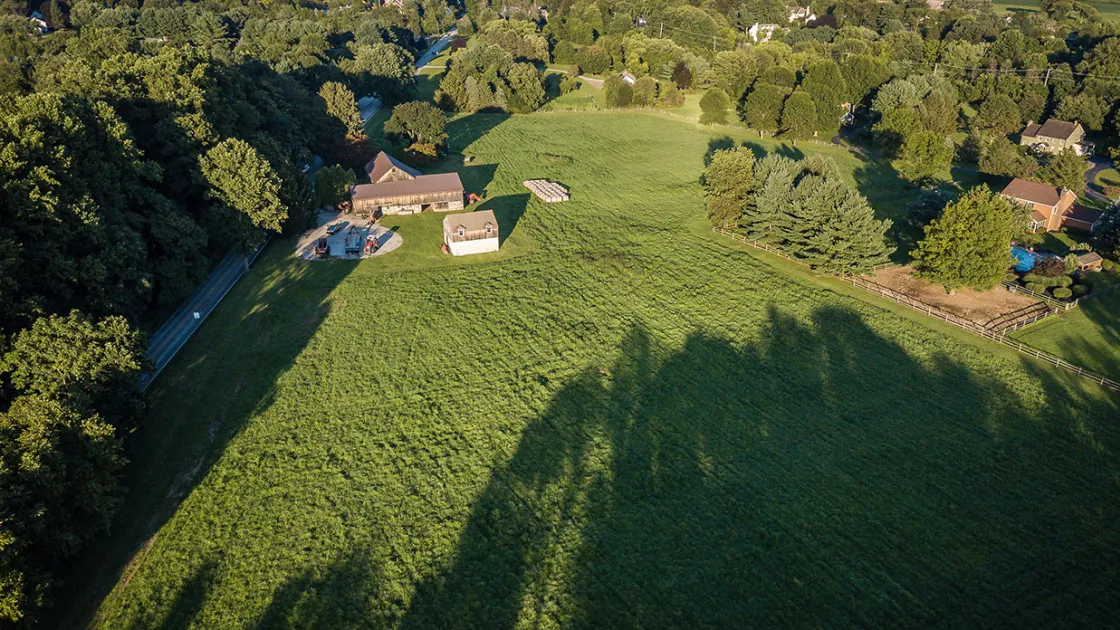Congressmen and Land Conservation Leaders Announce Preservation Victory at Brandywine Battlefield
(West Chester, Pa.) – On ground where George Washington’s troops narrowly escaped the British army’s grip, historic preservationists and land conservationists came together on Friday to celebrate protection of a key part of the Revolutionary War battlefield at Brandywine, continuing local supporters’ longtime work to protect this hallowed ground.
U.S. Congressmen Patrick Meehan and Ryan Costello joined Chester County officials, Campaign 1776 and the Brandywine Battlefield Task Force to announce that the scenic, 10.4-acre Dilworth Farm tract has been saved in perpetuity. Elements of George Washington’s Continental Army fought on and across this land, near the crossroads village of Dilworthtown, after a crushing British flank attack on Sept. 11, 1777.
The preservation of the Dilworth Farm marks the first time the American Battlefield Protection Program’s Battlefield Land Acquisition Grants, which are funded through the Land and Water Conservation Fund and administered by the National Park Service, have been used at a Revolutionary War Battlefield in Pennsylvania.

“Over the years, it has been wonderful to see so many partners coming together to preserve portions of this beautiful and historically significant battlefield,” Rep. Meehan told attendees at the news conference. “This hallowed ground needs to be preserved as an outdoor classroom so future generations can understand the sacrifices our founding generation made. I am especially pleased that the American Battlefield Protection Program, through the Land and Water Conservation Fund, was used for the first time in the Commonwealth to preserve an important Revolutionary War battleground.”
“The Land and Water Conservation Fund provides states and localities with the necessary resources to successfully implement conservation and historic preservation efforts, including the American Battlefield Protection Program,” said Rep. Costello. “In Southeastern Pennsylvania, conservation and education efforts create an important partnership in preserving open spaces for future generations to understand our history, and a perfect example of this partnership is the preservation of Brandywine Battlefield.”
Held during the battle’s 240th anniversary week, Friday’s celebration kicks off two days of living-history events at Sandy Hollow Heritage Park in Birmingham Township. Some 800 Revolutionary War re-enactors are expected to participate. Philadelphia’s new Museum of the American Revolution will exhibit a replica of George Washington’s headquarters tent, and living historians will portray figures who were present at the battle including Washington; Alexander Hamilton, Washington’s aide de camp; and the Marquis de Lafayette, the army commander’s young French protégé. Despite the British victory at Brandywine, Washington and his men soldiered on, renewing the fight again and again, and ultimately prevailing in the seven-year struggle against their highly experienced and better-equipped foe.
To cap Friday’s ceremony, stakeholders cut a ceremonial ribbon denoting the battlefield’s preservation, and members of the 1st Delaware Infantry Regiment fired a musket volley to honor the soldiers on both sides who fought at Brandywine. The uniformed re-enactors also performed fife and drum music.
Friday’s event was the first news conference held in Pennsylvania by Campaign 1776, a national initiative of the Civil War Trust to save Revolutionary War and War of 1812 sites. Campaign 1776 is also working to preserve acreage at the Princeton, N.J., battlefield where Washington rallied his men to repel British attackers, restoring popular faith in the American cause.
“Today’s announcement is a culmination of years of work done in partnership with the National Park Service to identify the most significant parts of the Brandywine Battlefield that are of the highest priority for preservation,” Trust President Jim Lighthizer said. “Campaign 1776 looks forward to other opportunities to help protect the Brandywine Battlefield, working with the great preservation and conservation groups represented here today.”
Lighthizer thanked the local community — Chester and Delaware counties, the Brandywine Conservancy, Birmingham Township and all the townships and residents in the battlefield — for their collective hard work to preserve the Brandywine Battlefield over many years.
Michelle H. Kichline, chair of the Chester County Board of Commissioners, noted that the Dilworth Farm’s preservation builds on decades of collaboration by local and state officials and area residents to share Brandywine’s history and protect the battlefield and its resources. The acquisition of Dilworth Farm adds to approximately 400 battlefield acres that have been protected within Chester County alone. The battlefield, however, measures 35,000 acres, and encroachment by Philadelphia-area development is always a threat.
“None of the battlefield would be preserved today if not for the work of the local community, partners and Brandywine supporters,” Kichline said. “Although Chester County has invested roughly $4.8 million in the preservation of the Brandywine Battlefield, it is critical to have support from the National Park Service through programs like the American Battlefield Protection Program, and from all of our nonprofit conservation partners.”
Kichline spotlighted the steadfast work of the Brandywine Conservancy on open-space and historic preservation issues. The Conservancy will hold the conservation easement for Dilworth Farm.
Molly Morrison, president of Natural Lands, then announced that her nonprofit conservation group is working with Campaign 1776 to safeguard a different site in the battlefield, a few miles to the west: 88-acre Osborne Hill. “In addition to being a beautiful stretch of Chester County countryside, Osborne Hill is an important historic site from which British Gen. William Howe directed the movements of his army during the battle,” Morrison said. “We are pleased to have the opportunity to preserve this important property. A major grant from the American Battlefield Protection Program has brought us very close to realizing our goal at Osborne Hill.”

On July 5, in a news conference at Antietam National Battlefield in Maryland, U.S. Interior Secretary Ryan Zinke announced an American Battlefield Protection Program land acquisition grant of $1.13 million for Osborne Hill. Reps. Meehan and Costello both represent the 88-acre Osborne Hill site, which straddles their districts. The Dilworth Farm is in Meehan’s 7th Congressional District. Both congressmen have been supportive of battlefield preservation and land conservation in the U.S.
Among America’s many historic battlegrounds, the Brandywine Battlefield stands out. In a 2007 report to Congress on the status of Revolutionary War and War of 1812 battlefields, the National Park Service identified Brandywine as a national priority for preservation because of its historic significance and opportunities to preserve intact battlefield landscapes.
“Preservation of the Dilworth Farm expands opportunities at the battlefield for public interpretation,” said historian Andrew Outten, chair of the Brandywine Battlefield Task Force. “Of any battle fought on American soil during the Revolutionary War, Brandywine had the most combatants engaged — 30,000—witnessed the most casualties and covered the largest area.”

“The Battle of Brandywine was the first fight to pair Washington and Lafayette, an influential aristocrat who helped persuade France to support the American revolutionaries in what became a global war.”
Dilworth Farm is not far from the battlefield’s Lafayette Monument and Birmingham Meeting House, also on Birmingham Road. James Dilworth’s family, namesake of the village and its Revolutionary-era Dilworthtown Inn, owned the farm from before the Revolution and into the 21st century. The family barn remains on site, providing continuity to the area’s rural historic landscape and buildings. The property is adjacent to the Dilworthtown Historic District, which is on the National Register of Historic Places.
Purchase of the Dilworth Farm property cost $850,000, paid for with grants from Chester County and the American Battlefield Protection Program, matched with private donations from the Civil War Trust. Once a conservation easement to protect this open space is recorded, Birmingham Township will take title to the property. Ultimately, Chester County’s battlefield preservation plan calls for a passive interpretive park here.
The Park Service’s Battlefield Land Acquisition Grant program has preserved 28,000 acres of historic battlefield land in 20 states. In 2014, Congress expanded the program to include Revolutionary War and War of 1812 battle sites.
About Campaign 1776
Campaign 1776 is a national initiative of the Civil War Trust, America’s premier nonprofit battlefield preservation organization. Its purpose is to protect the battlefields of the Revolutionary War and War of 1812, and to educate the public about the importance of these battlefields in forging the nation we are today. Learn more at Civilwar.org/campaign1776.
About the Brandywine Battlefield Task Force
The Brandywine Battlefield Task Force, a volunteer group including nonprofit organizations and municipal, state and federal representatives, works collaboratively to provide outreach and education, interpret, and protect the 1777 Brandywine Battlefield, its history and its resources. Learn more at: http://www.chescoplanning.org/HisResources/bbpp.cfm and http://www.chescoplanning.org/resources/PubsHisResources.cfm.
Campaign 1776 was created in 2014 as an initiative of the Civil War Trust; in May 2018 it became the Revolutionary War Trust, a division of the American Battlefield Trust.




